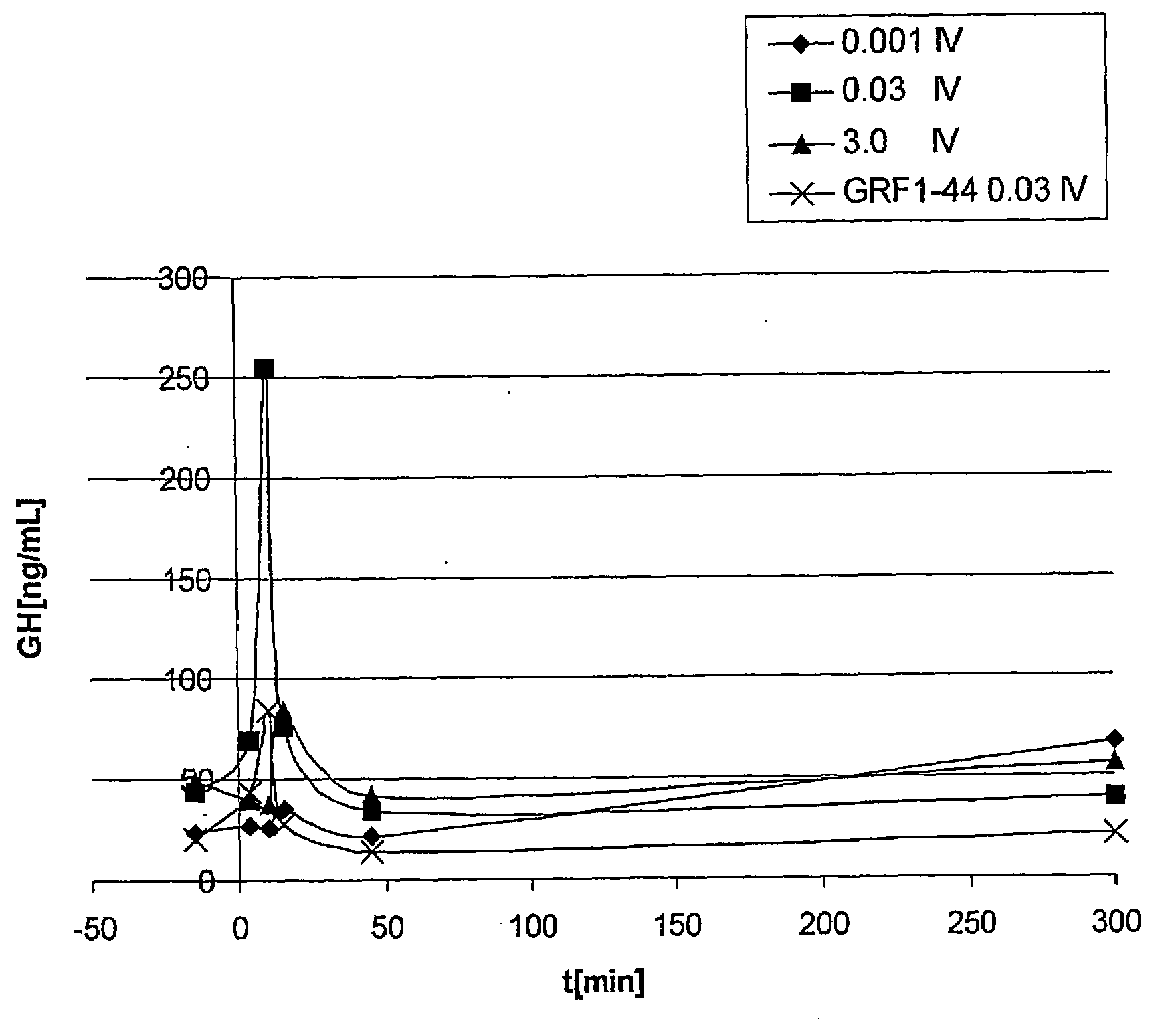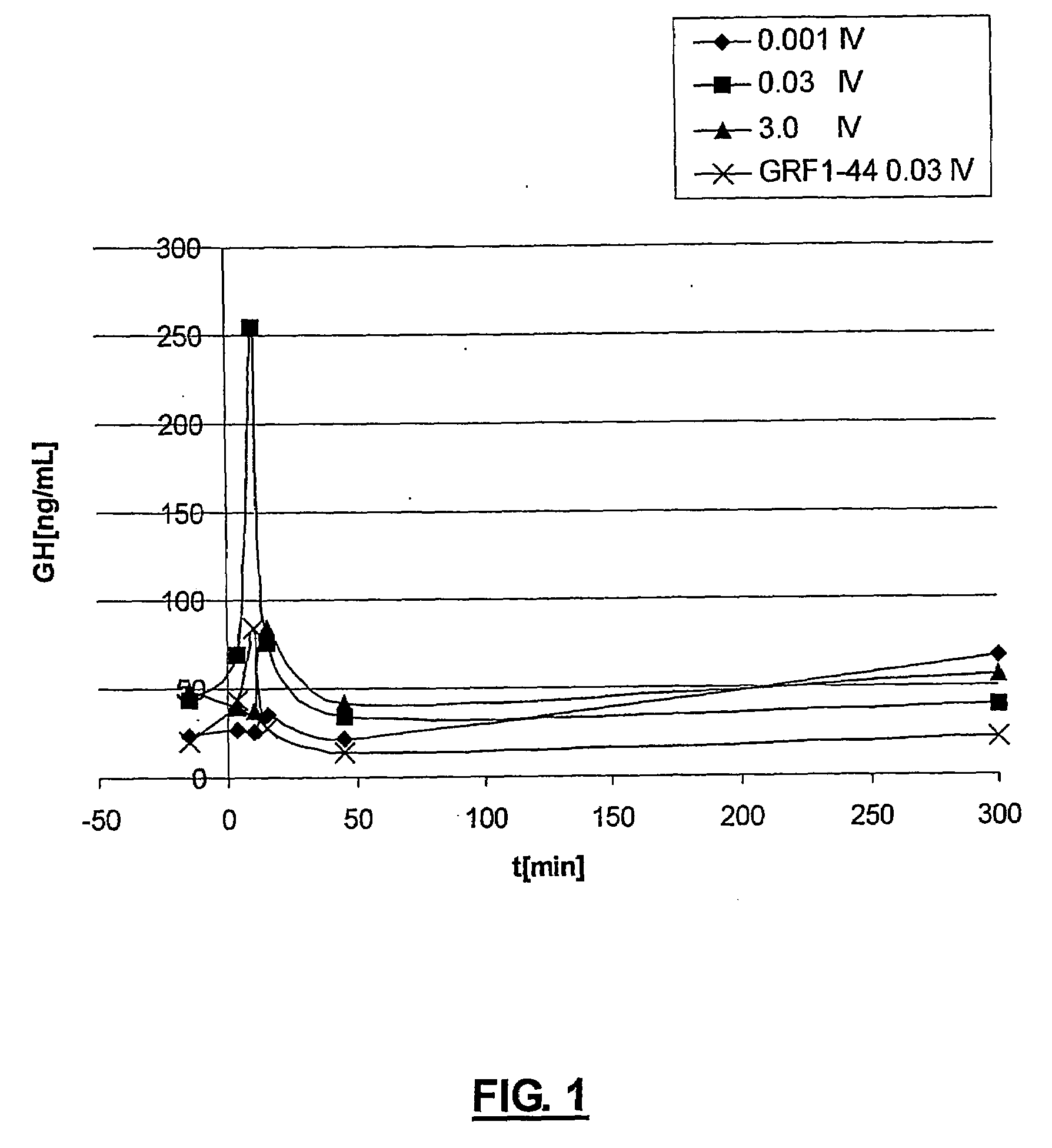GHRH analogues
a technology of growth hormone and analogues, which is applied in the field of growth hormonereleasing hormone (ghrh) analogues, can solve the problems of loss of high affinity binding sites and low patient complian
- Summary
- Abstract
- Description
- Claims
- Application Information
AI Technical Summary
Benefits of technology
Problems solved by technology
Method used
Image
Examples
example 1
Initial Selection of GHRH Analogues Based Upon In Vitro Data from GHRH Receptor Binding Affinity
[0062]Initial selection of a candidate from the original 14 polysubstituted GHRH analogues described in the U.S. Pat. No. 5,854,216 was based upon in vitro data on receptor affinity in 2-month old male Sprague Dawley rat anterior pituitary preparations. The new invention is based on the affinity of selected GHRH analogues for the human GHRH receptor (hGHRH-R) in baby hamster kidney (BHK) cells transfected with hGHRH-R, and on resistance to proteolysis in rat serum, human plasma or human serum. More precisely, the preferred drug candidates were selected, as compared to hGHRH(1-29)-NH2, for: i—their increased relative binding affinity to hGHRH(1-44)-NH2 binding sites in rat anterior pituitary in vitro as well as to hGHRH-R in BHK-expressing cells in vitro; and ii—their relative resistance to proteolysis in vitro.
[0063]As can be noted from Table 1 below, the relative binding affinity of the ...
example 2
Processing of the Native GHRH and GHRH Analogues of the Present Invention—Experimental Assays
[0064]125I-GHRH binding assay was performed as previously described (Boulanger L, et al. (1999) Neuroendocrinology 70: 117-127), using [125I-Tyr10]hGHRH(1-44)NH2 as radioligand. Competition experiments were done in BHK (baby hamster kidney) 570 cell membrane preparations (25 μg of protein / assay tube) with increasing concentrations (0-1000 nM) of human(h)GHRH(1-29)NH2, hGHRH(1-44)NH2 or GHRH analogues, in a total volume of 300 μl 50 mM Tris-acetate buffer (pH 7.4), containing 5 mM MgCl2, 5 mM EDTA and 0.42% BSA. Non specific binding was determined in presence of 1 μM hGHRH(1-29)NH2. Incubation was carried out at equilibrium (23° C., 60 min) and stopped by centrifugation (12,000 g, 5 min, at 4° C.). The radioactivity content in pellets was determined by gamma counting. The affinity of hGHRH(1-29) NH2 was tested in each experiment to assess the validity of the assay a...
example 3
In Vitro Proteolytic Resistance of Analogues Compared to hGHRH(1-29)NH2 in Rat Serum
[0079]As presented in Table 4, after a 60-minute incubation period, all GHRH analogues presented significantly higher residual concentrations in comparison with hGHRH(1-29)NH2. Moreover, the residual concentration of GHRH analogue #5 was significantly higher than that of either GHRH analogue 1, 2 or 3. Therefore, with the exception of GHRH analogue #4, these results indicate that GHRH analogue #5 exhibited the best in vitro resistance to proteolysis, using the described assay.
TABLE 4In vitro proteolytic resistance of analoguescompared to hGHRH(1-29)NH2 in rat serum.Duration ofResidual concentrationCompoundincubation (min)(% of initial concentration)Human GHRH(1-29)NH20100 ± 0 (n = 19)881 ± 21566 ± 33043 ± 26016 ± 1GHRH analogue # 10100 ± 0 (n = 3)8 75 ± 1215 70 ± 153053 ± 86030 ± 6GHRH analogue # 20100 ± 0 (n = 4)883 ± 31573 ± 53053 ± 36029 ± 2GHRH analogue # 30100 ± 0 (n = 4)882 ± 71588 ± 730 70 ± 1...
PUM
| Property | Measurement | Unit |
|---|---|---|
| pH | aaaaa | aaaaa |
| pH | aaaaa | aaaaa |
| particle size | aaaaa | aaaaa |
Abstract
Description
Claims
Application Information
 Login to View More
Login to View More - R&D
- Intellectual Property
- Life Sciences
- Materials
- Tech Scout
- Unparalleled Data Quality
- Higher Quality Content
- 60% Fewer Hallucinations
Browse by: Latest US Patents, China's latest patents, Technical Efficacy Thesaurus, Application Domain, Technology Topic, Popular Technical Reports.
© 2025 PatSnap. All rights reserved.Legal|Privacy policy|Modern Slavery Act Transparency Statement|Sitemap|About US| Contact US: help@patsnap.com



